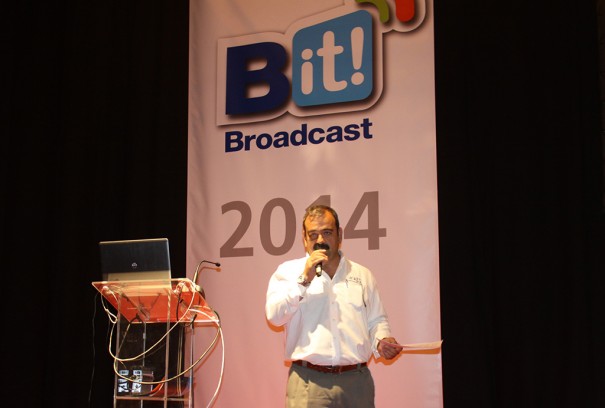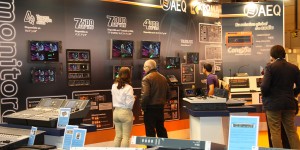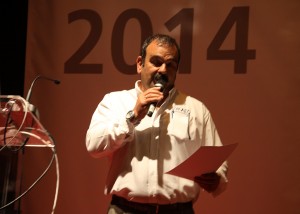AEQ desvela en BIT Broadacast las claves de la llegada del audio por IP a los estudios de radio
Javier Moreno, director comercial de AEQ, ha desvelado, en el workshop que ha impartido en BIT Broadcast, los beneficios que ha supuesto la llegada de IP a los estudios de radio. Una tecnología que ha optimizado la implementación de los sistemas de comunicaciones, aportando un audio de alta calidad y soluciones que han permitido una reducción de costes.
La radio está viviendo una revolución en lo que a las comunicaciones se refiere con la llegada de la tecnología IP. Como explica Javier Moreno, director Comercial de AEQ, “es la nueva forma de transmisión de audio convertida a datos. No es algo nuevo. Ya desde hace unos años, se ha estado aplicando a diferentes sectores en los que se buscaban diferentes soluciones a múltiples problemas”.
Javier Moreno ha explicado a los asistentes a BIT Broadcast, que hoy cierra sus puertas en IFEMA, cómo ha sido la llegada de IP a los estudios de radio y cuáles son las principales beneficios que aporta a estos entornos.
La tecnología IP ha afectado principalmente a las comunicaciones exteriores, la VoIP y la distribución de audio lineal multicanal dentro de los estudios de radio. “Aunque en el fondo todo esto es lo mismo, audio convertido a digital y transmitido a través de redes públicas o privadas de datos utilizando IP, (el protocolo de transmisión en Internet), la tecnología y los equipos son diferentes así como las necesidades a las que se pueden aplicar”.
Aunque en los tres campos ha supuesto una gran revolución la llegada de la tecnología IP ha sido en la transmisión de señales de audio donde realmente ha supuesto una gran novedad. Se trata de la posibilidad de realizar envíos multicanal dentro de cada emisora o estudio permitiendo un importante ahorro de cableado y una forma muy sencilla de distribuir las señales entre todas las consolas o equipos instalados.
El envío de audio multicanal no es algo nuevo “ya se estaba utilizando en los conciertos de grupos musicales desde hace casi 20 años y en el mundo de la radio lo que se ha estado utilizando, y en algunos sitios se sigue utilizando es el sistema MADI”.
MADI es un tipo de enlace que permite la transmisión de hasta 64 canales de audio por enlace de un punto de origen a un punto de destino determinado y fijo.
Con IP se ha conseguido disponer de un número de canales de audio solo limitado por la capacidad de la red, para todos los equipos conectados a ésta de forma simultánea. Todos los equipos conectados a esta red, pueden estar contribuyendo con señales para que sean seleccionadas por otros equipos de forma simultánea.
Su llegada a los estudios de radio ha sido tardía, sobre todo, por problemas de compatibilidad. En estos entornos existen una gran diversidad de equipos con muy diferentes funciones y de muy diversos fabricantes.
“AEQ, al igual que otros reconocidos fabricantes de equipos, ha estado esperando la aparición de una norma que haga que todos los equipamiento y marcas sean compatibles entre si. Y, aunque ya se sabe que será AES 67 todavía no no esta cerrada al 100%. Sin embargo mas de cien fabricantes, Solid State Logia, Yamaha, SAS, NTP, Studer y nosotros mismos, nos hemos puesto de acuerdo en utilizar la tecnología Dante que permite la interconexión de todas las marcas entre sí, y que en un futuro muy próximo, migrará a la compatibilidad AES 67 con una simple actualización. Todas las consolas digitales AEQ tienen ya en funcionamiento su módulo AoIP y se conectan directamente entre ellas o con cualquier equipo conectado en red. Otros fabricantes están llegando a soluciones equivalentes a través de la plataforma Ravennaen la que AEQ también participa, pero cuyos resultados pensamos no serán tan inmediatos ni efectivos en coste y flexibilidad.”
AEQ ha desarrollado los Net Box, unos equipos que disponen de un conjunto de entradas y salidas de audio analógicas y digitales que permiten conectar directamente a la red IP y así integrar todo el equipamiento auxiliar disponible en unos estudios. La configuración de señales de estos equipos se realiza a través del software de control general de la red y es compatible con la red de control y transmisión Dante.
Los audiocodificadores IP son equipos capaces de convertir una señal de audio en un flujo comprimido de datos para transmitir a través de redes privadas (Intranet) o a través de redes públicas como Internet.
Los primeros audiocodificadores se comenzaron a utilizar para redes de telefonía analógica y hoy en se siguen utilizando en lugares donde las redes digitales (Internet y RDSI) no se han impuesto como redes de calidad o son inexistentes. “Sin embargo, cuando realmente aparecen como se conocen de forma mas común, es con la llegada de las líneas RDSI. En un principio con bastante inestabilidad, pero luego se han convertido en una referencia del tipo de línea, por su capacidad de transmisión y estabilidad de la comunicación.
“En AEQ se ha tenido mucha experiencia con este tipo de equipos y algunos han llegado a ser una referencia en el mundo, como los codificadores portátiles AEQ TLE-02D o el ACD 3001 con el que se realizaron los campeonatos mundiales de fútbol en USA 1994 por primera vez utilizando esta tecnología”.
Estos codificadores para RDSI son la base de la nueva generación de codificadores sobre protocolo IP que presentan dos diferencias fundamentales, por un lado, la forma en la que las líneas de comunicaciones son capaces de transmitir esos datos (audio convertido) y, por otro, el protocolo de conexión entre origen y destino.
“En las líneas IP, los formatos de codificación para la transmisión son los mismos y se añaden nuevos formatos mas actuales, de mayor compresión y mejoras en relación a retardos y calidad”. Ahora se utilizan direcciones IP o, en el caso de la utilización de protocolo de comunicación SIP, un nombre con el que identificar al equipo.
Otra novedad que nos presenta la tecnología IP, en relación a las comunicaciones, es la posibilidad se sustituir las líneas o centralitas telefónicas por comunicaciones a través de Internet con el protocolo IP.
“Cada vez con más asiduidad se equipan las nuevas instalaciones con centrales telefónicas IP, lo que implica un problema a la hora de conectar mesas de mezclas, ya que no admiten la conexión directa de los híbridos tradicionales y nos provoca graves inconvenientes en la instalación”.
Para solucionar este problema, los fabricantes han desarrollado diferentes equipos como el Systel IP de AEQ que permite la conexión de teléfonos IP y terminales de control táctiles para realizar llamadas convencionales, desde la consola de mezclas a teléfonos particulares para sustituir las tradicionales llamadas telefónicas por líneas de AudioVoz sobre IP con centralitas IP.
Se trata de una nueva forma de comunicación que se presenta como una revolución para el entorno radiofónico ya que incorpora el audio sobre IP en los estudios de una forma transparente y sencilla de manejar, con equipos terminales y líneas de las que todo el mundo puede disponer en cualquier lugar. Y, además, supone un gran ahorro en las llamadas.
Did you like this article?
Subscribe to our NEWSLETTER and you won't miss anything.





